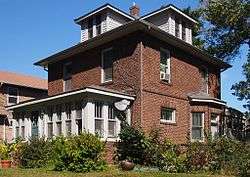Casiville Bullard House
|
Casiville Bullard House | |
 | |
  | |
| Location |
1282 Folsom Street Saint Paul, Minnesota |
|---|---|
| Coordinates | 44°58′47.7″N 93°7′56.7″W / 44.979917°N 93.132417°WCoordinates: 44°58′47.7″N 93°7′56.7″W / 44.979917°N 93.132417°W |
| Built | 1909 |
| Architect | Casiville Bullard |
| Architectural style | Other |
| NRHP Reference # | [1] |
| Added to NRHP | January 9, 1997 |
The Casiville Bullard House in Saint Paul, Minnesota, United States, is listed on the National Register of Historic Places. A skilled African-American stonemason and bricklayer, Tennessee-born Casiville Bullard, built this American Foursquare home for himself in 1910.[2]
Casiville Bullard was born in Memphis, Tennessee in 1873, the eldest of seven children. His parents were former slaves. He spent much of his youth picking cotton with his parents and babysitting his younger siblings. Although he only received a third-grade education, his uncle gave him instruction in "trowel trades" such as stonemasonry, bricklaying, and plastering. Slaves, in addition to being forced to perform agricultural labor, were often forced to repair and maintain buildings and to make clothing. As a result, many slaves became proficient in spinning, weaving, shoemaking, carpentry, painting, blacksmithing, and the "trowel trades". This knowledge was passed from one generation to the next, and many African Americans dominated these crafts after emancipation.[3]
In addition to the "trowel trades", Bullard also was educated in carpentry. He became very skilled at cutting and laying brick, marble, and granite, and cutting and laying pine and oak flooring. Racial prejudice began to manifest itself in the building industry in the South in the late 19th century, though. Locals of the Brotherhood of Carpenters and Joiners union were segregated, so black workers were predominantly sent only to poor black neighborhoods. The trowel trades unions were much less likely to discriminate, because most of their skilled craftsmen were black. Even with that, though, many African American craftsmen migrated to northern cities between 1890 and 1910, in an effort to escape housing discrimination, segregation laws, and the loss of political power and legal rights. Bullard was one of the craftsmen who moved to the north, moving to St. Paul, Minnesota in 1898 to work on the Minnesota State Capitol, a Cass Gilbert design.[3]
References
- ↑ National Park Service (2007-01-23). "National Register Information System". National Register of Historic Places. National Park Service.
- ↑ Nord, Mary Ann (2003). The National Register of Historic Places in Minnesota. Minnesota Historical Society. ISBN 0-87351-448-3.
- 1 2 Gardner, Denis P. (2004). Minnesota Treasures: Stories Behind the State's Historic Places. St. Paul, Minnesota: Minnesota Historical Society. pp. 196–199. ISBN 0-87351-471-8.
External links
- Casiville Bullard House, St. Paul, MNopedia.
- "The House that Bullard Built", Minnesota History, Minnesota Historical Society, Summer 2004